“Everyone who has ever been involved with the German Institute and its work knows this man”
This entry is dedicated to Angelis Kosmopoulos, a Greek who helped shape the image of the German Archaeological Institute at Athens for decades.
The basic facts of Angelis Kosmopoulos’s life (ca. 1843–1937) have been recounted many times, and are well-known (Goessler 1951, 32; Moustaka 2012, 177 fig. 4; Kankeleit 2021, figs. 15, 20). Since a wide range of various sources, however – scholarly publications, excavation reports, personal accounts by different archeologists, and even archival documents – give a detailed, lively record of his personality and work with the DAI, it is worthwhile to gather them all together here. That said, it is not possible, nor is it the goal of this essay, to present an exhaustive account of Kosmopoulos’s collaboration with the DAI Athens. The purpose here is to capture the essence of that collaboration.
The first and earliest records of Kosmopoulos’s work on the German excavations at Olympia were compiled and published in part by Klaus Herrmann (Herrmann 2007, 28). They are taken from Tagebuch V, covering the 1879/1880 campaign of the old Olympia excavations. (Information about the old Olympia excavations is drawn from the material about Wilhelm Dörpfeld and the history of the excavations at Olympia that Herrmann compiled in exacting detail for years and which today remains at the DAI Athens as the ‘Klaus Herrmann Papers’.) There, Angelis is mentioned as the supervisor of thirty workers at the eastern end of the stadium.
A concise description of Angelis penned by the archeologist Friedrich Hiller von Gaertringen (Hiller von Gaertringen 1901, 26 f.) in 1901 – heavily indebted to the style and zeitgeist of his time – transports us in medias res:
”Everyone who has ever been involved with the German Institute and its work knows this man. Since the beginning of the excavations at Olympia, he has always, again and again, been active in the service of the Institute. On every one of the great trips to the Peloponnese, he bore the ultimate responsibility for securing mounts and lodgings for all the participants as they traveled through mountainous Arcadia. In his Greek national dress, the fustanella, and with his broad, now graying beard and his honest, fearless, and intelligent expression, he is one of the best and most appealing exponents of the unspoiled, powerful Hellenic Volk, dedicated to his task and to the person of his master with his whole soul. He wields absolute authority over his workers, whom he treats fairly and with rare impartiality, while not permitting any carelessness on their part” (Hiller von Gaertringen 1901, 26).
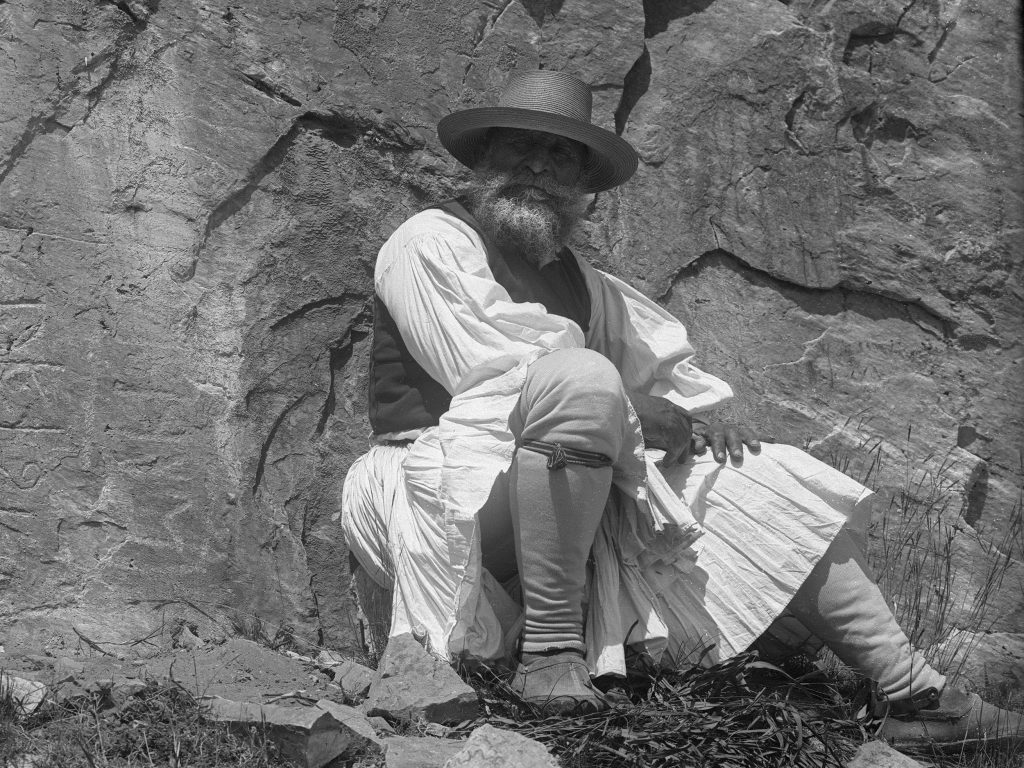
Hiller von Gaertringen knew Angelis well: he had worked for Hiller and his colleagues several times (1896, 1897, 1899, 1902) as a foreman and excavation supervisor on Thera (fig. 1). In addition to the description above, which derives from a public lecture for a general audience, Hiller mentions Angelis repeatedly in his excavation reports, describing his good archeological eye, his initiative, and his efficient work manner (fig. 2): ”Not far from the highest point in the city, on July 13, Angelis happened upon the corner of a marble base, which turned out to be an altar to Hestia. On his own initiative, he had the men dig further and found the corner of a building. The next day proved that the move was a good one: no fewer than two youths’ heads, […] a large Hellenistic statue of a woman, […] and the dedication of a gymnasiarch were found in the building” (Hiller von Gaertringen 1899, 29 and 31). ”Of course, Angelis was not satisfied with carting away debris from this badly preserved tangle of walls that had been reworked at a later date; and when Angelis is not happy with his finds, he looks for something better. Thus, on March 11, he had already deployed a few workers at a corner of the wall […]” (Hiller von Gaertringen 1904, 5).
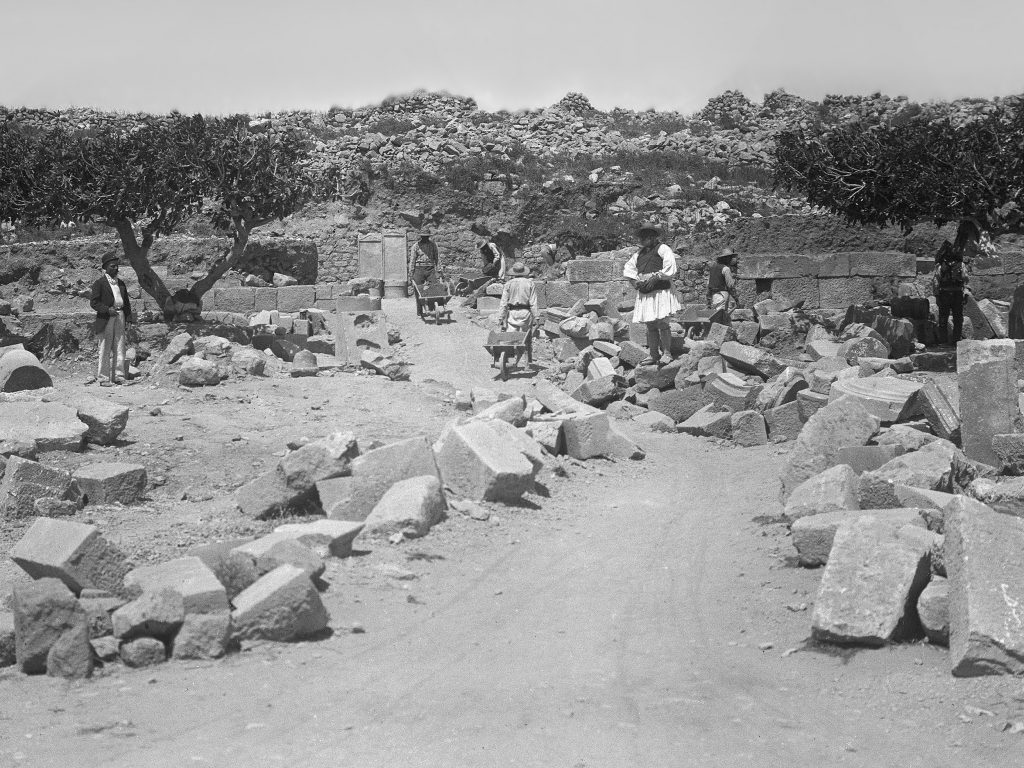
Angelis not only brought tools from the mainland, but also actively searched for find sites, supervised workers, haggled over the price of antiquities for museum purchases, secured lodgings for the scholarly staff and looked after their physical wellbeing (e.g. Dragendorff 1903, 7), and supported the archeologists in practical terms by solving a variety of technical problems; in this way, he won everyone’s respect. Among other things, he erected – from a modern perspective – hair-raising structures on site, such as a temporary platform that one reached via three ladders stacked one on top of the other, on which Hiller copied inscriptions (Hiller von Gaertringen 1904, 24 with illustrations).
The Institute liked to assign Angelis to young archeologists whom he could help with his experience, such as Otto Rubensohn on Paros from 1897 to 1899 (D-DAI-ATH-Paros-0008). The Institute trusted Angelis so completely that, among other destinations, it sent him (together with at least two more foremen) to Egypt in 1900 as foreman to Ernst von Sieglin´s excavations at Alexandria as suggested by Dörpfeld. The accounts and wage lists, that Angelis kept, as well as photographs of him taken during the campaign, are now preserved in Tübingen (Laube 2012, 32 n. 12, 34 fig. 13).
In the years 1905–1914, Angelis was always at Dörpfeld’s side as he increasingly pursued his own research interests in Homeric Greece, undertaking excavations at Tiryns, Kakovatos (‘Old Pylos’), Leukas (‘Ihaka’), Olympia, and Corfu (e.g. Karo 1959, 83); numerous photographs of him at the various excavation sites bear witness to this fact (figs. 3, 4).
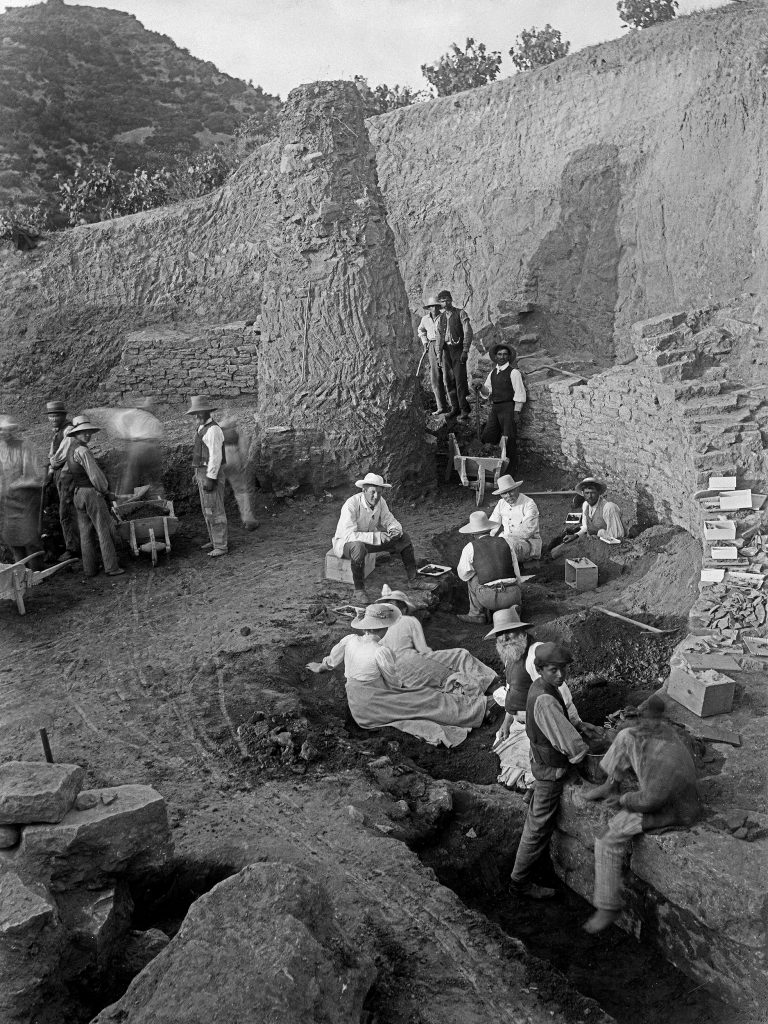
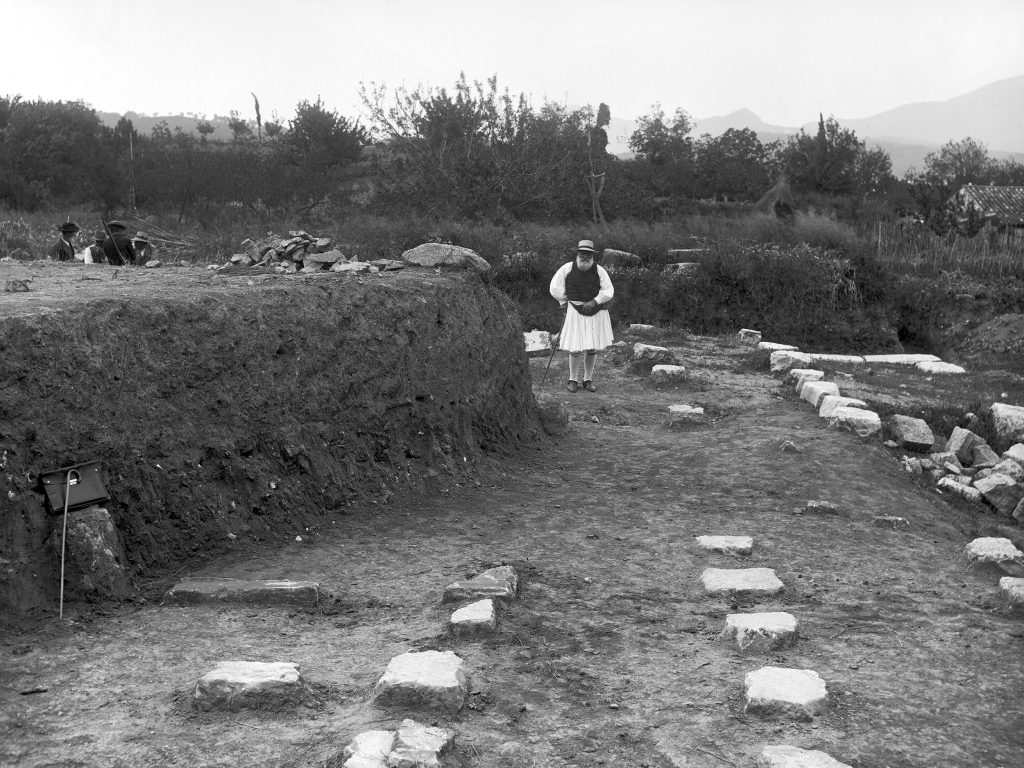
Angelis’s personal ties to the Institute were not limited to Dörpfeld, but rather grew and extended from one generation of young archeologists to the next:
When excavations in Tiryns resumed under the direction of Georg Karo in 1910, Angelis Kosmopoulos supported him as foreman (Karo 1959, 80 f.). A photograph that survived from 1914 shows both men working together in the field on the excavation (fig. 5).
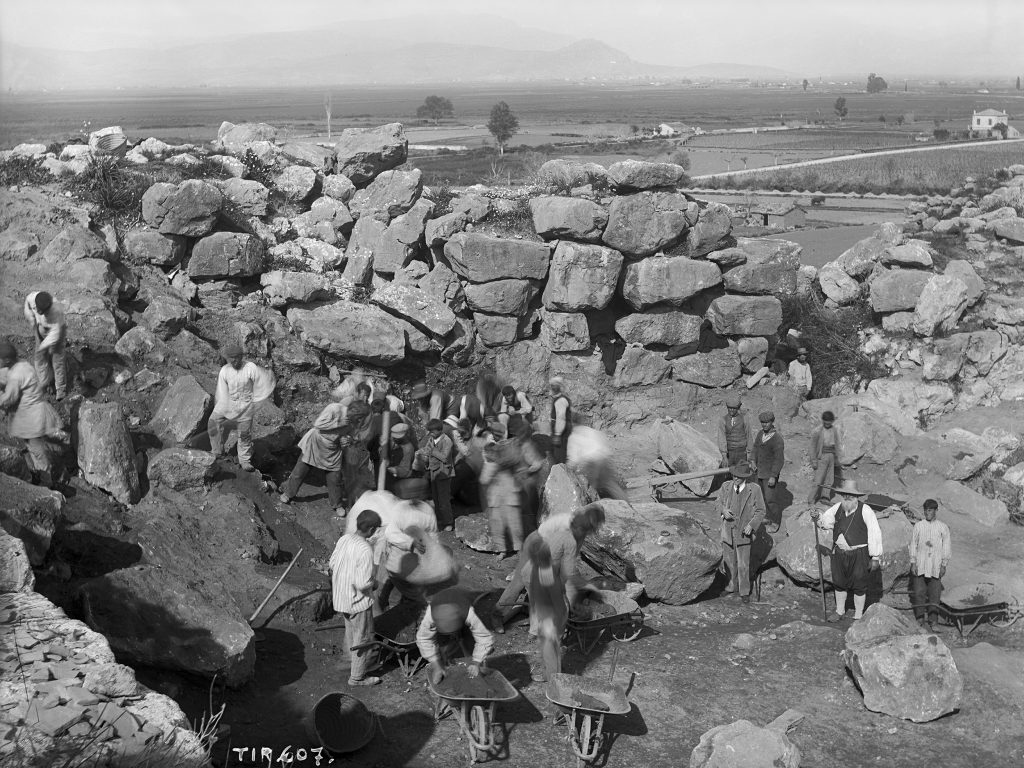
As we have seen, there are countless photographs of Angelis Kosmopoulos from all his years of service, easily recognizable on account of his distinctive dress (D-DAI-ATH-Tiryns-0049, D-DAI-ATH-Tiryns-0050, D-DAI-ATH-Tiryns-0071). Another source provides valuable insight into the existence of this photographic abundance. In 1901, Friedrich Seiler took part in all three of the trips led by Dörpfeld that spring; he gave an account of them first in short journal contributions and, in 1904, in a book. Seiler often makes mention of Angelis and discusses him specifically at the end of the trip to the Peloponnese (Seiler 1904, 179 f.):
”Here Angelis, whose service ended today, was photographed for the last time. This important person is actually named Kosmópoulos, a name no one ever uses, though, and comes from Magouliana in north Arcadia. His father had been involved with the German archeologists as a foreman at the excavations in Olympia. He himself passed his relationship with the Germans down to his sons Georgios and Vassili, of whom the former, a young man of about twenty, also accompanied us. His father [i.e. Angelis] is one of those phenomenal characters you cannot forget once you have come into close contact with them. His handsome, gray beard – Angelis is about sixty years old – lends him an air of dignity, and his Greek national dress, a white fustanella and similar leggings, suits him perfectly. His white leather belt had great allure for all the Greeks we ever dealt with. It served not only as a holder for his handkerchiefs, knife, and tools, but also as a wallet. From it sprang those much sought-after, greasy drachma bills that rained down over the poor villages on our route like a life-bringing shower. Angelis was an outstanding Reisemarschall. He rented the mounts along with their drivers, bought provisions for our lunches, and mediated everything between ourselves and the Greek population. He seemed to be a familiar figure all over the Peloponnese. All the horse drivers, peasants, and tavernkeepers bowed to him, […]. Yet Angelis was always friendly and humble, usually serving us personally at lunch with devoted enthusiasm. On account of these qualities, he enjoyed the greatest popularity among the trip participants. Everyone wanted to have a picture, if possible, and he gradually became indisputably one of the most photographed people in Greece. One sees his characteristic figure not only in the large photographs that the Institute’s photographer or Dörpfeld himself customarily took during the trips, but frequently private Kodaks of all sizes were also pointed all too eagerly at him, and countless times he was posed like a sacrificial lamb by columns, in front of house doors, on stone bases and memorialized on glass and film. He knew that he could make himself seen, and so he was very happy to pose”.
Seiler thus emphasizes the organization of the Institute’s expeditions as Angelis’s key area of responsibility even more than Hiller von Gaertringen (fig. 6).
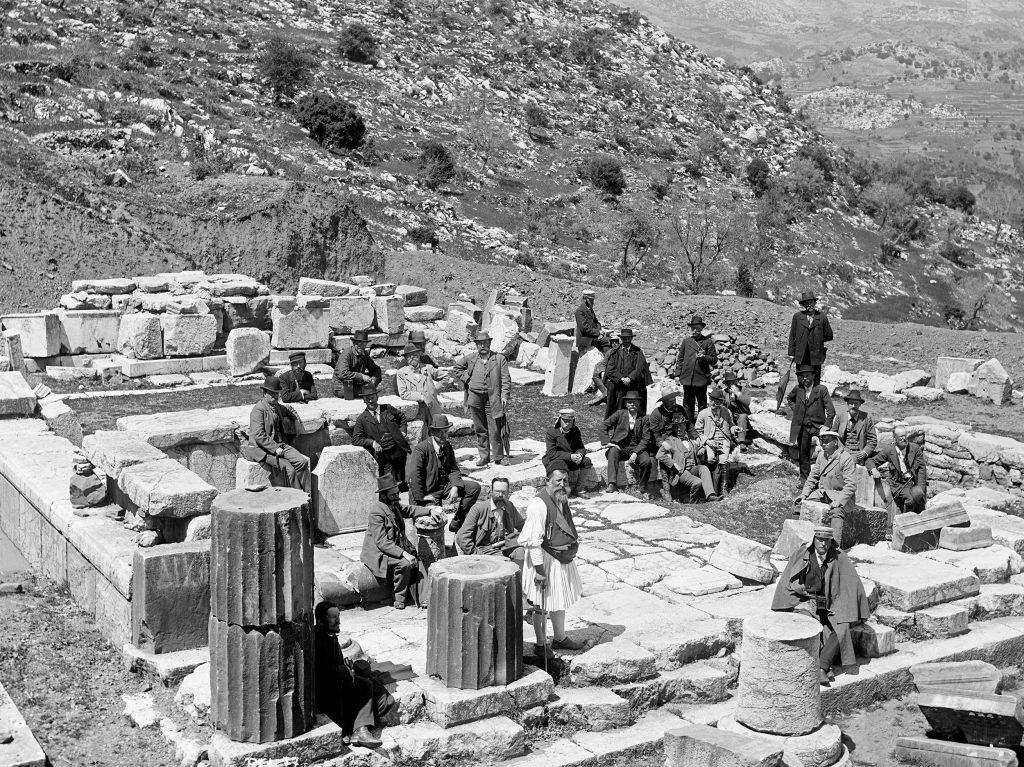
One of the highlights of the Institute’s annual trips was the visit to the theater in Epidaurus. To entertain the travelers there, small shows were staged, the Ancient Greek chorus was imitated, and circle dances were performed. Angelis was evidently one of the protagonists here, too (fig. 7).
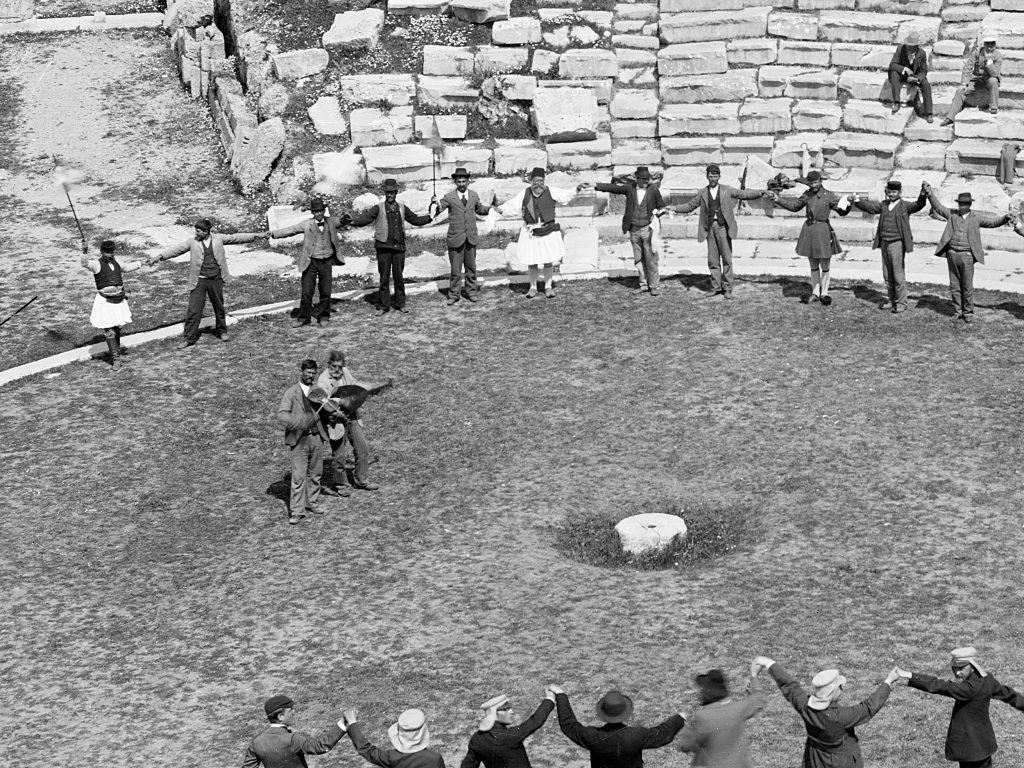
Although Angelis had begun his career as a foreman and was still regularly active as such, by about 1900 his official designation, as it were, appears to have been ”tour leader”.
That emerges especially clearly from a document connected to the award of medals to distinguished members of the Institute and Greek archeologists in leading functions on the occasion of the 25-year anniversary of the department: on February 25, 1900, tour leader Angelis Kosmopoulos, employee of the Athenian department of the Archeological Institute, received from His Majesty, the Emperor and King, as represented by the Foreign Office, the Medal of the Crown Order, which was awarded to him at the dedication of the Institute’s newly constructed hall (fig. 8). This honor naturally marked a highlight of Angelis’s relationship with the Institute in Athens.
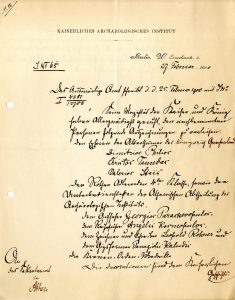
Episodes from his life also brought Angelis personal recognition. Julius Ziehen, who was on a travel scholarship, for instance, fell into a serious fever in Sparta in 1892, which – it was believed at the time – could be treated with champagne. Angelis was duly dispatched: he searched every store in Sparta for champagne until he finally found a cobweb-covered bottle with a cork and a strange fastener that proved to be the requisite medicine, and which indeed also helped the grateful patient.
Angelis not only served the Institute on tours and excavations. He also occasionally helped out in the headquarters in Fidiou, as emerges from expense books. For example, in September 1909, he received pay as a construction guard, apparently in connection with the construction of the Trikoupi Wing (Sporn 2018, 15).
Angelis’s fame and distinctive appearance led to another honor of a very special nature – a curiosity, in fact. As mentioned above, Dörpfeld’s loyal companion, Angelis also took part in the excavations of Kaiser Wilhelm II in Corfu, which the latter not only financed but also followed with keen interest (e.g. Karo 1959, 83–90).
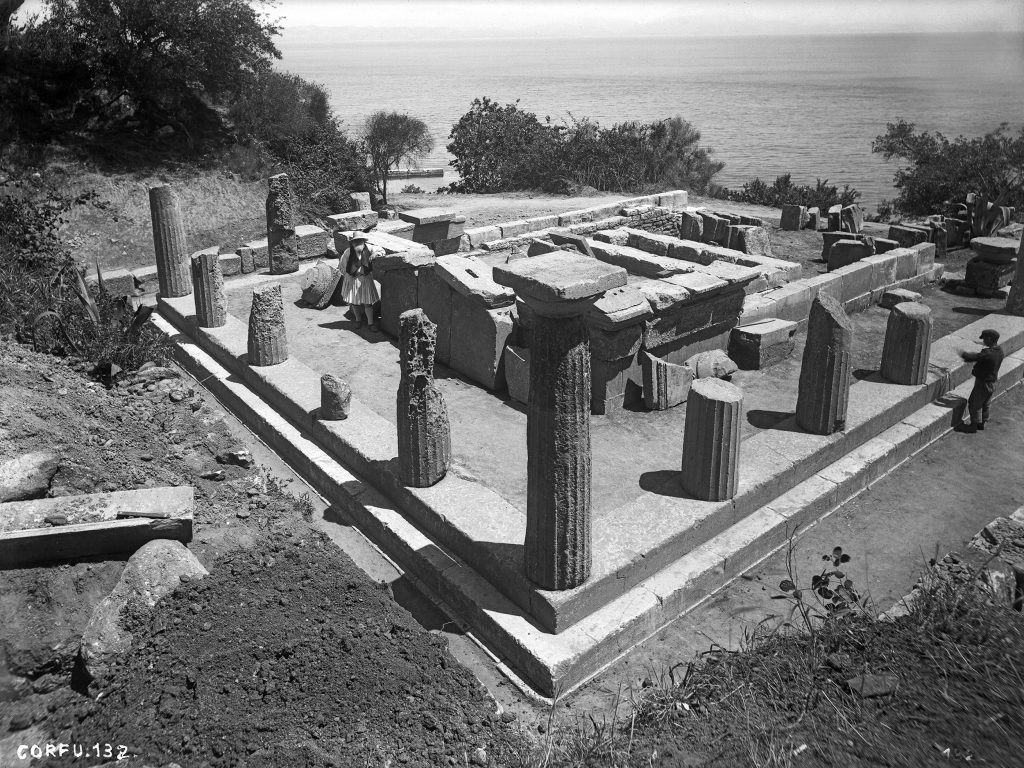
When Joseph Lauff staged the play ‘Kerkyra’ (fig. 10) for Kaiser Wilhelm II on Corfu on the occasion of the discovery of the Gorgo Temple in 1913 (link: https://www.akg-images.com/archive/-2UMDHUNWCG8K.html, last visited on September 24, 2021), contemporary dances from Corfu were performed in the second part of the program ”with an archeologist and his foreman Angelis” as Dörpfeld puts it in the manuscript of his autobiography Mein Lebenslauf (p. 145), which is kept today in the city archives of Wuppertal.
In Lauff´s play, the figure of the dancing Angelis was probably inspired by real-life events. Most likely, Lauff was aware of the Greek circle dances performed in the Kaiser’s honor on Corfu (Karo 1959, 94) (cf. also the dances in Epidauros mentioned above). His decision to include Angelis in the play may therefore have been based on Angelis’s appearance in traditional dress, his relationship with Dörpfeld, and his prominent role at the excavation on Corfu itself.
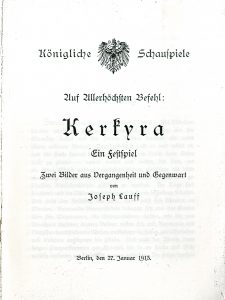
It is well known that Dörpfeld remained in regular contact with his ca. ten-years-older friend Angelis Kosmopoulos until an advanced age (Moustaka 2012, 177 fig. 4; Kankeleit 2021, figs. 15, 20). Dörpfeld even appears to have drafted plans for a house for the Kosmopoulos family in Magouliana (Kienast in print; Vogeikoff-Brogan 2020). That draft, in my opinion, might have been connected to the family of Angelis’s son Georgios Kosmopoulos and his wife Leslie Walker-Kosmopoulos. This couple (see also Vogeikoff-Brogan 2020) had their own connection to Dörpfeld, which we will explore another time.
Angelis’s importance to the DAI at Athens can be observed literally until his final breath: as late as April 1937, Angelis was present at the reopening of the excavations in Olympia (Kankeleit 2021, 191 with n. 93 and fig. 15). Three documents concerning him from November 18, 1937, survived in the archive of the DAI Athens, and are soon available online as part of the project ARCHAthen. In one telegram, the Kosmopoulos family informs the DAI from Magouliana of the passing of its longstanding collaborator. On the same day, the leading director, Walther Wrede, informed Dörpfeld by telegram of the death of his friend and also expressed his condolences to Angelis’s family in a very personal and compassionate letter (fig. 11). Thus, closed a circle of almost sixty years of close collaboration between Angelis Kosmopoulos and the German archeologists of the DAI at Athens.
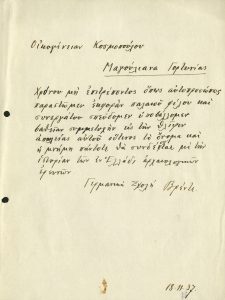
Works cited:
Dragendorff 1903
Dragendorff, H., Thera: Untersuchungen, Vermessungen und Ausgrabungen in den Jahren 1895–1902. Vol. 2: Theraeische Gräber (Berlin 1903)
Herrmann 2007
Herrmann, K., ”Wer nie Pilaf mit Unschlitt aß …” Das alte Grabungshaus in Olympia und seine Bewohner, in: H. von Steuben (ed.) et al., Beiträge zur antiken Plastik – Festschrift zu Ehren von Peter Cornelis Bol (Möhnesee 2007) 13–40
Hiller von Gaertingen 1899
Hiller von Gaertingen, F., Thera: Untersuchungen, Vermessungen und Ausgrabungen in den Jahren 1895–1898. Vol. 1, Die Insel Thera in Altertum und Gegenwart: mit Ausschluß der Nekropolen (Berlin 1899)
Hiller von Gaertingen 1901
Hiller von Gaertingen, F., ‘Ausgrabungen in Griechenland.’ Vortrag gehalten am 12. November 1900 in der Aula der Universität Rostock zum Besten der Errichtung einer Bismarcksäule (Berlin 1901)
Hiller von Gaertingen 1904
Hiller von Gaertingen, F., and P. Wilski (eds.), Thera: Untersuchungen, Vermessungen und Ausgrabungen in den Jahren 1895–1902. Vol. 3, Stadtgeschichte von Thera (Berlin 1904)
Kankeleit 2021
Kankeleit, A. ”Er lebt allein im Kampfe für seine Idee.” Wilhelm Dörpfeld in der Zeit des Nationalsozialismus, in: M. Weidhaas-Berghöfer and A. Eich (eds.), Eine Odyssee – Studien zum Leben und Werk Wilhelm Dörpfelds (Wuppertal 2021) 162–212 https://www.kankeleit.de/pdfs/akankeleit_doerpfeld_2021.pdf
Karo 1959
Karo, G., Fünfzig Jahre aus dem Leben eines Archäologen (Baden-Baden 1959)
Kienast forthcoming
Kienast, H. J., Wilhelm Dörpfeld als Architekt, Athenische Mitteilungen (forthcoming)
Moustaka 2012
Moustaka, A., Die deutschen und griechischen Ausgrabungen, in: W.-D. Heilmeyer (ed.), Mythos Olympia: Kult und Spiele (Munich 2012)
Seiler 1904
Seiler, F., Griechische Fahrten und Wanderungen: Reiseeindrücke und Erlebnisse (Leipzig 1904)
Sporn 2018
Sporn, K., Das Deutsche Archäologische Institut: Entwicklung und Bedeutung, in: Das Deutsche Archäologische Institut in Athen: Architektur und Geschichte Athens (Athen 2018)
Sporn 2019
Sporn, K., Travel and Research: Journeys and Travel Grant Recipients at the DAI Athens, in: K. Sporn and A. Kankeleit (eds.), Die Abteilung Athen des DAI und die Aktivitäten deutscher Archäologen in Griechenland 1874–1933, Tagung DAI Cluster 5 in Athen Deutsches Archäologisches Institut und Benaki Museum, 12. bis 13. Dezember 2016, Beiträge zur Geschichte der Archäologie und der Altertumswissenschaften 2 (Wiesbaden 2019) 49–66
Vogeikoff-Brogan 2019
Vogeikoff-Brogan, N., On the Trail of the ‘German Model’: Τhe American School of Classical Studies at Athens and the German Archaeological Institute (DAI), 1881–1918, in: K. Sporn and A. Kankeleit (eds.), Die Abteilung Athen des DAI und die Aktivitäten deutscher Archäologen in Griechenland 1874–1933, Tagung DAI Cluster 5 in Athen Deutsches Archäologisches Institut und Benaki Museum, 12. bis 13. Dezember 2016, Beiträge zur Geschichte der Archäologie und der Altertumswissenschaften 2. (Wiesbaden 2019) 253–267
Vogeikoff-Brogan 2020
Vogeikoff-Brogan, N., ”An Unconventional Union: Mr. and Mrs. George Kosmopoulos.” From the Archivist’s Notebook, 2020 [web blog]. March 14, 2020. https://nataliavogeikoff.com/2020/03/14/an-unconventional-union-mr-and-mrs-george-kosmopoulos/ Accessed September 21, 2021
Ziehen 1980
Ziehen, H. Julius Ziehen: Erinnerungen 1864–1925 (Frankfurt 1980).
